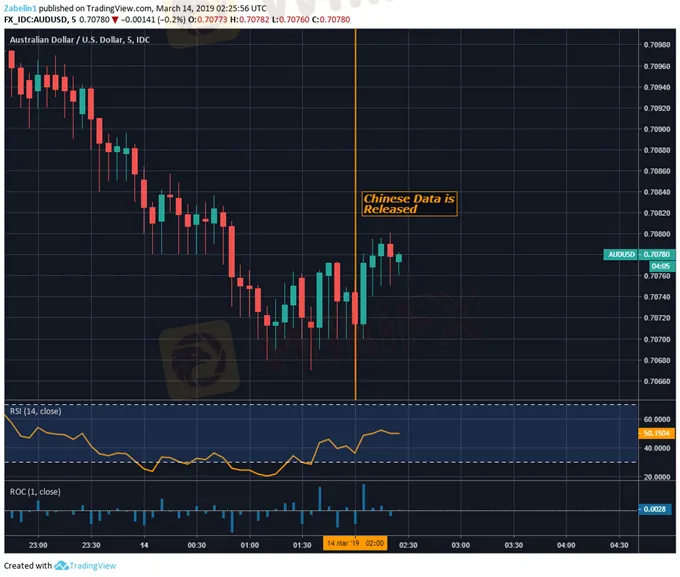简体中文
繁體中文
English
Pусский
日本語
ภาษาไทย
Tiếng Việt
Bahasa Indonesia
Español
हिन्दी
Filippiiniläinen
Français
Deutsch
Português
Türkçe
한국어
العربية
AUD/USD Edges Lower on Soft Chinese Industrial Production Data
Abstract:The Australian Dollar slipped following the release of Chinese industrial production. Will continued slower growth in China prompt the RBA to cut rates, sending AUD/USD
AUD TALKING POINTS – AUD/USD, CHINA INDUSTRIAL PRODUCTION, RBA
AUD/USD falls on soft Chinese industrial data
Will slower China growth push RBA to cut rates?
Global risk likely to continue weighing on Aussie
See our free guide to learn how to use economic news in your trading strategy!
AUD/USD fell to a session low following the release of underperforming year-on-year Chinese industrial production for February. The report came in at 5.3 percent and missed the 5.6 forecast, subsequently leading the Aussie to slide. Other data that was released included retail sales, the jobless rate and property investment, though they didn‘t appear to significantly influence the Australian Dollar’s movement.
AUD/USD – 5-Minute Chart

Slower growth in China will likely to continue to weigh on the sentiment-linked Aussie, not least because China is Australias largest trading partner. While headlines over the trade conflict between Beijing and Washington have become increasingly less of a concern relative to other immediate event risk, the fragile relationship between the two may still weigh on bullish sentiment for AUD.
Adding general doubts about Aussies strength, RBA governor Philip Lowe recently stated that there is no strong case for near-term adjustment in rates. Despite initially planning to raise them as their next move, the outlook has shifted to be more “balanced” with overnight index swaps pricing in a higher probability of a cut over a hike. This comes as housing prices deflated and may begin to impact consumer spending, potentially undercutting a viable reason for raising rates.
Looking ahead, Aussie traders may be monitoring China‘s upcoming home prices data scheduled for March 15. Because the economic docket remains relatively light for the rest of the week, it is possible the Australian Dollar’s price movement will be dictated more by external developments. These include US-China trade relations, the upcoming Brexit vote and indications on the direction of global growth.
Disclaimer:
The views in this article only represent the author's personal views, and do not constitute investment advice on this platform. This platform does not guarantee the accuracy, completeness and timeliness of the information in the article, and will not be liable for any loss caused by the use of or reliance on the information in the article.
Read more

Australian Dollar Eyes Chinese Economic Data, Will AUD/USD React
Australian Dollar is in focus with Chinese economic data on tap to kick off APAC trading. Japan’s Q3 GDP crossed the wires at -3.0% q/q, missing analysts’ expectations of -0.7%. AUD/USD looks to move higher after a Bullish Engulfing candlestick pattern forms

Currencies wait for RBA to kick off big central bank week
The dollar hovered below recent highs on Tuesday as traders waited for the Reserve Bank of Australia to lead a handful of central bank meetings set to define the rates outlook this week.

Stocks Mixed As RBA Leaves Rates Alone, Australian Data Mixed Too
Equities were mostly lower, if not by very much. Australian interest rates remained at record lows. That was as expected, but retail sales disappointed as the current account surged ahead

Australian Dollar Ticks Up, China Caixin PMI Flags Surprise Expansion
The Australian Dollar got a small burst of life on news that Chinas private manufacturing sector did better than its large, state-run partner last month.
WikiFX Broker
Latest News
Will Gold Prices Continue to Rise Due to Trump’s Tariffs?
Miami Firm Owner Pleads Guilty to $6M Ponzi Scheme Fraud
NBI Cebu Arrests Forex Trader for Illegal Investment Solicitation
PU Prime's "Feather Your Trades" Contest! Begin
eToro Files for IPO with $5 Billion Valuation on NASDAQ
Is FizmoFX a Scam? Fraud and Account Suspension of Traders
Why the Federal Reserve Is So Important
Boerse Stuttgart Digital Secures EU-Wide MiCAR Crypto License
BOJ to Announce Policy Decision This Week, Market Bets on a Rate Hike
Crypto.com’s Dual Front Battle: European Progress and U.S. Regulation
Currency Calculator






